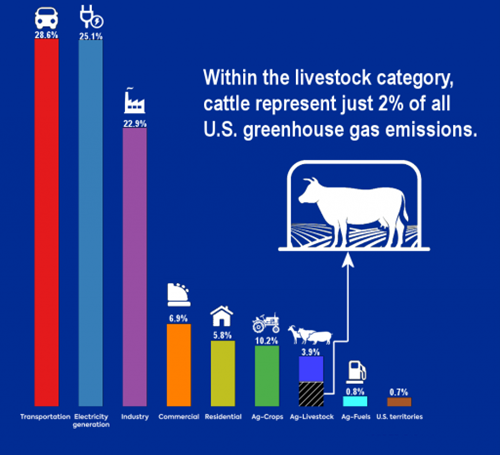New York City Mayor Eric Adams has targeted “emissions intensive” food consumption for tracking and gradual government-mandated limits, in order to reduce the city’s alleged climate change impacts. Adams’ focus on the food New Yorkers eat is misguided at best and authoritarian and ineffective at worst. In fact, tracking carbon dioxide emissions from food production and consumption is complicated, and ultimately unhelpful, because data show meat and dairy, the likely prime targets for Adams’ food policing policies, contribute very little to global emissions, despite what alarmists assert.
A story in Gothamist, a news site run by New York Public Radio, titled “NYC will target food choices in its battle against climate change,” describes Adams’ crusade against meat and dairy consumption in New York City. The mayor’s office announced a plan to start tracking the carbon footprint that everyday household consumption has, and “a new target for New York City agencies to reduce their food-based emissions[.]”
The “household consumption tracker” will detail all the emissions involved in the production, transportation, and consumption, of common household items, especially food. The mayor’s office claims that, “20% of the city’s greenhouse gas emissions come from food consumed by households,” and “officials said New Yorkers can help the planet by eating more fruits, vegetables, grains, and beans.”
The article also reports that Adams’ plan goes beyond monitoring and restricting food choice at public hospitals, schools, and cafeterias in government buildings, rather “Adams is asking private sector companies to cut their emissions by 25 percent by 2030.” Gothamist doesn’t mention who the “private sector companies” are, but if that includes the city’s hundreds of butchers, steakhouses, pizza places, Michelin star restaurants, and mom and pop diners and delis, for which meat and dairy food items make up the core of their business, or are popular items on their menus, this will sharply curtail their income and likely result in closed businesses and significantly fewer dining choices.
Adams is not the first politician to suggest limiting or changing what people eat to fight climate change. In Australia, for example, schools came under fire for incorporating insect powder in children’s lunches in order to force kids to have “eco-friendly” eating habits. Climate Realism discussed this in “Correct, The Epoch Times, Eating Bugs is Not Necessary or Desirable,” pointing out that while eating bugs is common in some parts of the world, the driving factor is poverty and starvation, not desire. Insects can actually be dangerous to consume, with the consumption of locusts and grasshoppers causing a notable percentage of fatal allergic reactions in China.
Besides the economic and social implications of Adam’s efforts to police food consumption, and the questionable legality and ethics of controlling individual’s food choices, Adams’ police state food monitoring and any regulatory limits that flow from it are unlikely to have any measurable effect on climate change. Evidence presented in Climate Realism, here, for example, suggests that “eating local” does little or nothing to reduce greenhouse gas emissions and may, under some circumstances, increase them. Large farms producing huge quantities of produce, grown efficiently, actually probably have a lower emissions impact than small-scale local farms, even when emissions from transportation are included.
Livestock do not have nearly the emissions impact Adams claims. Research from Prof. Habil Wilhelm Windisch, Ph.D., of the Technical University of Munich, for example, shows that grazing livestock like cows and sheep actually only contribute about 5 percent of greenhouse gas emissions, as opposed to the 20 percent figure claimed by Adams.
Data from the U.S. Environmental Protection Agency, provided in Climate at a Glance: Livestock and Methane, confirm this, reporting that beef cattle make up only 2 percent of emissions, with the rest of U.S. livestock accounting for less than 4 percent of domestic greenhouse gas emissions. (See figure below)

Adams’ push to track and control what New Yorkers eat is anti-scientific and authoritarian. The only way his rules might actually reduce the city’s “carbon footprint,” will be if it results in the closure of popular New York restaurants and businesses, providing New Yorkers one more reason to leave a city that is already bleeding businesses and people. Contrary to alarmists’ claims, the data on food production and alleged eco-friendly lifestyles shows that there is no measurable benefit to dictating peoples’ food choices. Contrary to the assumptions behind Adams’ plan, replacing beef, pork, and chicken, with fruit, bugs, and beans will not prevent climate change.


















…or even measurably affect it.
” It is a tale told by an idiot, full of sound and fury, signifying nothing.” (HT: W Shakespeare)
This column still has the high quality it originally had when written by H. Sterling Burnett in the past. Linnea is doing a great job. This blog editor recommends every one of her columns for his 20 best articles of the day reading lists. Just like anything written by H. Sterling Burnett.
https://honestclimatescience.blogspot.com/
Agreed, Richard. Linnea is an unusually talented writer, something that is sadly lacking among today’s “journalists.”
Stop the insanity. Thank God for our food and liberties. Leave our meat and dairy alone. Your
Climate propaganda is disgraceful. Stop hurting Americans and our freedoms